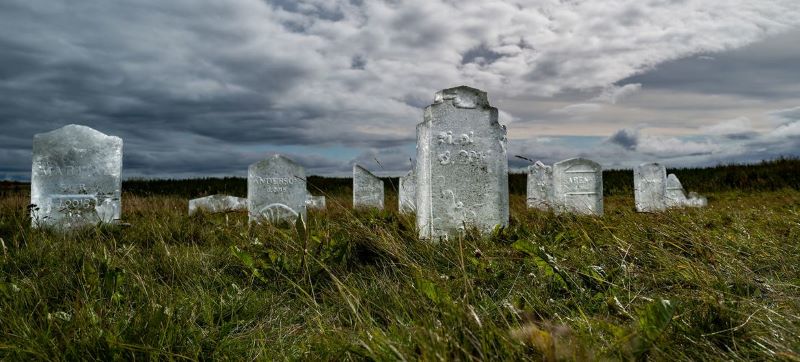 Glacier
Glacier
World's first global glacier graveyard unveiled in Iceland
Iceland´s glaciers are retreating so rapidly that future generations may wonder how the ancient island nation got its name.
No surprise then that the land of the Vikings was chosen to house the world’s first global glacier graveyard which was unveiled at a ceremony last month, close to the capital Reykjavik.
Coinciding with the powerful and symbolic monument to the ravages of unchecked climate change, the ceremony on 17 August also saw the publication of The Global Glacier Casualty list of 15 extinct and endangered glaciers by Rice University in Texas – a driving force behind the whole project.
According to scientists, global warming has led to the disappearance of thousands of glaciers around the world since the year 2000. It is expected that at least half of these glaciers will be lost by 2100.
Researchers from Rice University in Houston, the Icelandic Met Office, geologists, glaciologists and Government leaders attended the ceremony ahead of what will be the International Year of Glaciers´ Preservation, in 2025.
UNESCO, the UN Educational, Scientific and Cultural Organization and UN weather agency WMO, were among the many co-organizers of the event in Iceland.
Headstones, a ‘poignant reminder’
The glacier graveyard is made up of 15 headstones carved from ice by Icelandic ice sculptor Ottó Magnússon.
“We have never needed a graveyard for glaciers before,” Rice University´s Cymene Howe said. “Now we do. And while these headstones will melt away – like their glacial counterparts – we hope the ceremony and icy gravestones serve as poignant reminders that the world’s glaciers are doomed to the same fate without quick action.”
The headstones were placed in a field next to the sea in the Seltjarnarnes peninsula, adjacent to Reykjavík, with a splendid view of the Snæfellsjökull glacier across the Faxaflói-bay.
The Snæfellsjökull glacier is well-known to students of world literature as the entrance and embarkation point for the protagonists in Jules Verne´s classic science fiction novel, Journey to the Centre of the Earth.
Although the Snæfellsjökull glacier has lost more than half of its size since the end of the 19th century, there are many glaciers that are worse off.
Among the biggest casualties listed as “disappeared”, are the Pizol Glacier, Switzerland (2019), the Sarenne Glacier, France (2023), the Anderson Glacier, USA (2015) and the Martial Sur Glacier, Argentina (2018).
More will follow
Five years ago, the premature death of the Ok glacier in Iceland was commemorated in a ceremony attended by then Prime Minister of Iceland Katrín Jakobsdóttir and former President of Ireland Mary Robinson.
“Since that glacier has its plaque and fame we opted for another Icelandic glacier for the first entry to the list,” one of the organisers, Hrafnhildur Hannesdóttir glaciologist at the Icelandic Met Office, told the UN Regional Information Centre for Western Europe (UNRIC).
“It is likely that many others will follow, since there are no indications that emissions of CO2 are diminishing.”
Iceland has already lost 70 of its 400 glaciers. Some of them, like the next candidate for extinction, Hofsjökull East, are indeed very small. “It is relatively low lying and flat and will not survive for long,” said Hannesdóttir.
Sea level set to rise
If all of Iceland’s glaciers disappear, the meltwater would create a one centimetre rise in the global sea level - almost as much as all the glaciers in the Himalayas, according to Icelandic glaciologist Thorsteinn Thorsteinsson, in an interview with UNRIC.
The glaciers in the Himalayas cover around 40,000 square kilometres. However, Vatnajökull, which is Iceland´s – and indeed Europe’s – largest glacier south of the Arctic Circle, alone covers 7,700 km2.
For various reasons “the big one” as it is known, is expected to survive for perhaps three more centuries.
Iceland’s second largest glacier, Langjökull is, on the other hand, in greater peril, not least because it is much more low-lying. Scientists predict that only 10 to 20 per cent of its mass will remain by 2100.
Water Tower of Asia
The melting of glaciers in the Himalayas attracts much more attention than the fate of those in Iceland, for understandable reasons.
The glacierized mountains of the Hindu-Kush-Himalaya region have been called the “Water Tower of Asia” since the feed some of the Earth´s most important rivers such as the Indus, Ganges, Brahmaputra and Yangtze – all of which originate there in what is a relatively small area.
They are considered “a lifeline for hundreds of millions, if not billions of people” in the words of Thorsteinsson. They have already lost 40 per cent of their volume since the end of the 19th century.
It is predicted that 75 per cent will be lost by the end of this century.
“But their melting does not mean that 2-3 billion people in China and India will die of thirst. The Ganges for instance has its origins in a small glacier, the Gangotri. Rain and snow will continue to fall and groundwater and the monsoon feed into all of these great rivers,” he told UNRIC.
His colleague Hrafnhildur Hannesdóttir points out that the melting has caused increased risk of floods and mudslides, with a frequent and high death toll.
“One has to look at the big picture, not focus on only one thing at a time, and we should not forget the sea level rise which will impact even more people.”
Crucial to humanity’s story
There is also an important cultural dimension: “These are all glaciers wrapped up in our lives,” Rice University´s Dominic Boyer said.
“They belong to the time that we have together, not abstract future losses, but real losses that you can feel and will feel with all of your senses.”
Indeed, the glaciers are also a part of Iceland’s identity. The national flag features a red cross outlined in white with a blue body.
The cross stands of course for Christianity, the red for the fire of the volcanos, the blue for the sky and the sea, and the white for ice and snow.
The silver lining is that the white might not disappear - even if the glaciers do.
The magnificent Snæfellsjökull may lose its status as a glacier, but its white cap might remain. “As a matter of fact, the glacier ice on the mountain is relatively thin and its colour is greyish and not very pretty,” explains Thorsteinsson.
“But it will not stop snowing, and indeed it is the snow cap that we most admire from afar and all photographers love.”
International year
The UN General Assembly has declared 2025 the International Year of Glaciers’ Preservation and proclaimed 21 March of each year the World Day for Glaciers.
Support Our Journalism
We cannot do without you.. your contribution supports unbiased journalism
IBNS is not driven by any ism- not wokeism, not racism, not skewed secularism, not hyper right-wing or left liberal ideals, nor by any hardline religious beliefs or hyper nationalism. We want to serve you good old objective news, as they are. We do not judge or preach. We let people decide for themselves. We only try to present factual and well-sourced news.







